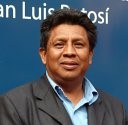Sociedad Mexicana de Ciencia y Tecnología
de Superficies y Materiales A.C.

Sociedad Mexicana de Ciencia y Tecnología de Superficies y Materiales A.C.
XV International Conference on
Surfaces, Materials and Vacuum
September 26th - 30th, 2022 / Puerto Vallarta, Jalisco

Elías Pérez,PhDInstituto de Física E. Perez is a Physicist by the UAM-I. His PhD studies were on Physico-Chemistry of Macromolecules in the Institute Charles Sadron, France. Two postdoctoral positions followed his formation: in the University of Konstanz, Germany, and INSERM 424 in Strasbourg France. He spent a sabbatical year at the Institute Curie, Paris, France. His current position started in April 2000 attending graduate and undergraduate students in his laboratory. He teaches with the Faculty of Sciences and Chemistry in the UASLP, but also participates in the Material Science Postgraduate Program in the same University. |
||
Dependence of the liquid polarity in the wetting on a rough surface: a effective surface tension approachSurface wetting is characterized by the liquid (usually water) contact angle on the surface, and it has been the subject of numerous studies for many years, Young’s equation (1805) describes many of that phenomenon. However, this equation is no longer valid for rough and inhomogeneous surfaces. Instead, Wenzel (1936) and Cassie–Baxter (1944) have proposed alternative equations that take into account the roughness and inhomogeneity, respectively. In this talk we present an approach based on the equation of state (EQS) that describes very well the wetting of liquids on a rough surface using an effective surface tension, this implicitly contains information about roughness, liquid-surface interaction and inhomogeneities. Indeed, experimental results show that the liquid and surface polarity is an important issue in wetting on rough surfaces. These results shown that low polar liquids show little dependence on roughness of a low polar surface, while the high polar liquids are very sensitive to it. As consequence, the calculated contact angles by EQS and by the surface tension components (STC) were close to experimental values only for high polar liquids, while low polarity liquids differ greatly from them.
|